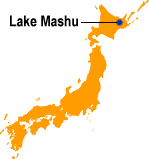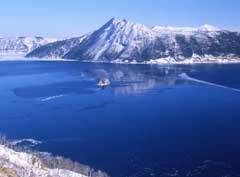
March 8, 2009
Continuing a yearly tradition since he began guest blogging here, Brent Swancer passes along his third March 8th posting. – Loren.
Japan’s Giant Crayfish
By Brent Swancer
Is there an unidentified giant crayfish inhabiting Japan’s lakes? For years, occasional reports of extremely large, unexplained crayfish have surfaced in northern Japan, most notably in Hokkaido’s Lake Mashu.

Known to the Ainu people as “Kamuy-tou,” or “The Lake of the Gods,” Lake Mashu is located in the northeast part of Hokkaido, Japan. It is a caldera lake, formed in the crater of a dormant volcano approximately 11,000 years ago.

Surrounded by high, sheer cliffs, Lake Mashu lies 315 meters (1,033 ft) above sea level, is 20 km in circumference, and 212 meters (695 ft) deep at its deepest point. The lake is notable for having some of the clearest water in the world. Lake Mashu is also famous for the thick fog that veils it for most of the summer months, resulting in it’s nickname “foggy Lake Mashu.” The lake is quite remote, with access to the shoreline limited.

Since at least the 1970s, there have been reports of something strange in the lake. Accounts have surfaced over the years of crayfish far exceeding the size of any known to be in Japan. In 1978 and 1985, trout poachers are reported to have captured extremely large crayfish in the lake. In total, there were three alleged specimens gathered by these poachers, although the claims could not be confirmed due to the illegal nature of the circumstances surrounding the capture of the creatures. Another account comes from one author of a survey of known crayfish in the lake, entitled “Crayfish in Lake Mashu, Hokkaido,” who reported that he had once captured a male crayfish specimen when he was a young man which had a carapace that measured a whopping 47 cm (18.5 inches) in length. It is important to remember that this figure is only for the length of the carapace, and not the total length of the specimen, which would be much longer.

There have been other scattered reports of giant crayfish in the lake as well. In one such report, a fisherman described seeing a crayfish crawling along the bottom in the clear water of the lake that he estimated as being at least 3 feet long.
Japan has only one species of endemic crayfish, the Japanese crayfish (Cambaroides japonicus), that inhabits the cold, clean waters of lakes, ponds, and streams in northern Japan. It is not a particularly large crayfish, reaching sizes of only 4 to 7 cm (2 to 3 inches) in total length, with an average carapace length of 3.5 cm (1.4 inches). Perhaps more importantly, it is not known to inhabit Lake Mashu.
The other two species of crayfish known to live in the wild in Japan are introduced species. One is the the invasive Louisiana crayfish, or red swamp crayfish (Procambarus clarkii) from North America. It is found all over Japan, on all of the major islands. This species is even smaller than the signal crayfish, reaching sizes of 5.5 to 12 cm (2.2 to 4.7 inches) in total length. It too is not known to be present in Lake Mashu.
The only species of crayfish known to inhabit Lake Mashu is the introduced signal crayfish of North America (Pacifastacus leniusculus). This species was imported to Lake Mashu from Oregon and the Columbia River system in the 1930s as a potential food source. The signal crayfish reaches sizes of up to 15cm (5.9 inches) in length, with an average carapace length of 3 to 6 cm (1.2 to 2.4 inches), far from the enormous sizes reported for the mystery crayfish of Lake Mashu.
In the summer of 1992, there was a study of crayfish in the lake. Of the 171 males and 517 females caught in tangle nets during this study, no specimen had a carapace length of more than 5.7 cm (2.2 inches). Incidentally, this species has since been introduced to other lakes throughout Hokkaido, where it is notable for posing a serious threat to native Japanese crayfish. The signal crayfish has seriously threatened the native species in many areas through predation, competition, and as a carrier of crayfish plague, a type of water mould that infects crayfish. It is so invasive that it was put on the list of alien species that are banned in Japan under the Invasive Alien Species Law enacted in February, 2006.
So what could be behind the reports of mysterious giant crayfish? The fish in Lake Mashu, such as sockeye salmon and rainbow trout, as well as the sole species of crayfish known to be there, are all introduced from elsewhere. Since Lake Mashu is a Caldera lake, there are no endemic species there. There are also no rivers or significant waterways connected to the lake. The lake is a completely isolated habitat.

Perhaps when trying to ascertain what is going on, the first possibility to consider is other types of introduced, exotic crayfish. The world’s largest species of crayfish, indeed the largest freshwater invertebrate, is the Tasmanian giant freshwater crayfish (Astacopsis gouldi), above and below.

These crayfish reach average sizes of at least 40 cm (15.7 inches) in total length, but even huger sizes of up to 80 cm (31.5 inches) in total length and weighing up to 6 kg (13.2 lbs) have been recorded. The second largest is the Murray crayfish (Euastacus armatus) of the Australian mainland, which reaches overall lengths of 20 to 30 cm (7.9 to 11.8 inches) and weights of up to 2 kg (4.4 lbs). These vulnerable species are both currently protected by Australian law, and they are also banned in Japan by the 2006 Invasive Species Law.
Crayfish are popular as pets in Japan, so it seems at least plausible that perhaps some unsuspecting aquarists have bought specimens of one of these Australian species and dumped them when they got much bigger than expected. However, although these Australian species are large, the sizes still don’t seem to add up. Keep in mind that the measured Lake Mashu specimen I mentioned earlier was recorded as being 18.5 inches long for its carapace alone (not it’s total length). The total length of such a monster from head to tail would be bigger than even the largest known crayfish species.
One possibility is that the known crayfish in the lake have seen some instances of gigantism. Beyond insular gigantism (island gigantism) in their isolated lake environment, there are several factors that could contribute to large sizes in the crayfish. For instance, these large sizes could come about as an adaptation for competing for scarcer food resources, which could possibly lead to delayed sexual maturity that would result in greater size. The Lake Mashu specimen that was measured was a male that was described as having exceptionally large chelae, or pincers. Since adult male signal crayfish in the lake do not exhibit secondary sexual characteristics in their chelae, this suggests that some degree of neoteny (delayed maturity) could be occurring. This means the specimen could even have possibly been still growing.
Gigantism in the crayfish could also have occurred as an adaptation for more efficient temperature regulation and lesser need for continuous activity in the cold depths of the lake. Although crayfish favor cold water, Lake Mashu reaches extremely low temperatures, and is frozen over from December to April. Organisms with lower surface to mass ratios can manage body heat better, and minimize heat lost to their surroundings, a phenomenon known as gigantothermy. This characteristic can be seen in some deep sea and cold water arthropods, so perhaps something similar is happening in Lake Mashu with crayfish.
The high oxygen content of the lake may also be a contributing factor. One suggested hypothesis for phenomena such as Polar gigantism (the tendency for some cold dwelling, polar animals to reach larger sizes), is that high availability of oxygen relieves constraints on the body’s ability to transport oxygen which in turn allows for attaining larger sizes. Lake Mashu is an oligotrophic lake, meaning it has generally low nutrient levels and productivity. For instance, there is a distinct lack of algea in oligotrophic lakes, a condition which actually contributes to the clear water seen in places like Lake Mashu. The flip side is that this cold, clear water provides high oxygen levels, making it an ideal habitat for animals like the lake’s introduced rainbow trout and salmon, which favor such conditions. This high oxygen level could have perhaps contributed to gigantism in the crayfish.
Larger size has also shown in studies to be a distinct advantage for both inter- and intra- specific competition for shelter among crayfish. Shelter is an important, limited resource for crayfish, perhaps especially so in a place like Lake Mashu, which has a bottom that is almost flat and covered with pumice deposits. Maybe some specimens have begun to get larger due to ever increasing competition for prime hiding places.
The only problem with hypotheses on factors for gigantism is the time frame involved. Changes like this typically take a long time, and crayfish have only been present in the lake since the 1930s. Crayfish are generally fairly long lived creatures, that take many years to reach sexual maturity. This means there simply will not have been many generations born in the lake during which such changes would occur. The chances of such dramatic size adaptations developing so rapidly, and in so few generations, seem somewhat low.
Whatever they are, the giant crayfish of Lake Mashu make for an interesting mystery.
Clawnote: Of course, being from Maine, darn, these just look like our run-of-the-mill lobsters (but, of course, those are marine, not freshwater animals)! ~ Thanks, Loren.
In June 2006, 16-year-old Louie Smith caught this giant lobster while fishing off a pier in Kent, UK. The lobster weighed 11 lbs 3 oz and could have been 100 years old. After posing for a photograph the lobster was thrown back into the ocean.
In January 2009, Neil Robinson, of Portsmouth N.H., carries an allegedly 140 year old, 20-pound lobster to freedom in Kennebunkport, Maine.
Finally, an unidentified chef holds aloft two giant crayfishes for diners in
South Africa.
About Loren Coleman
Loren Coleman is one of the world’s leading cryptozoologists, some say “the” leading living cryptozoologist. Certainly, he is acknowledged as the current living American researcher and writer who has most popularized cryptozoology in the late 20th and early 21st centuries.
Starting his fieldwork and investigations in 1960, after traveling and trekking extensively in pursuit of cryptozoological mysteries, Coleman began writing to share his experiences in 1969. An honorary member of Ivan T. Sanderson’s Society for the Investigation of the Unexplained in the 1970s, Coleman has been bestowed with similar honorary memberships of the North Idaho College Cryptozoology Club in 1983, and in subsequent years, that of the British Columbia Scientific Cryptozoology Club, CryptoSafari International, and other international organizations. He was also a Life Member and Benefactor of the International Society of Cryptozoology (now-defunct).
Loren Coleman’s daily blog, as a member of the Cryptomundo Team, served as an ongoing avenue of communication for the ever-growing body of cryptozoo news from 2005 through 2013. He returned as an infrequent contributor beginning Halloween week of 2015.
Coleman is the founder in 2003, and current director of the International Cryptozoology Museum in Portland, Maine.
Filed under Cryptomundo Exclusive, Cryptotourism, CryptoZoo News, Cryptozoologists, Cryptozoology, Eyewitness Accounts, Folklore, Guest Blog, Megafauna, Weird Animal News